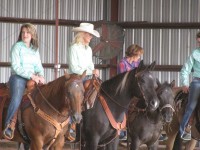 If your horse is currently not experiencing any symptoms of laminitis, making sure he is healthy and ready for warmer weather and greener pastures can prepare him for the coming season. If your horse has laminitis symptoms already, then there are precautions you can take.
If your horse is currently not experiencing any symptoms of laminitis, making sure he is healthy and ready for warmer weather and greener pastures can prepare him for the coming season. If your horse has laminitis symptoms already, then there are precautions you can take.
1. Check Weight and Insulin Levels – Overweight horses and insulin-resistant horses are both prone to laminitis. Before you turn your laminitis horse out on pasture, make sure that he is at a healthy weight. If your horse is overweight, you probably need to help him lose weight before spring with diet and exercise. Have some blood work done on your horse to check on insulin levels. Insulin-resistant horses may or may not be overweight, but are prone to grass founder or laminitis. Signs of insulin resistance include a cresty neck and unevenly distributed fat over the withers and base of the tail.
2. Check Overall Health – Laminitis horses tend to experience symptoms when they are generally unhealthy. Signs that your horse isn’t healthy include poor hair coat, eye discharge, change in temperament, stiffness, sensitivity to hot or cold weather or weather changes. Increasing his nutritional program and adding ½ cup chia seeds juice plus a daily packet of algae, probiotics and enzyme capsules can help most horses nutritionally.
3. Vaccinations – Over-vaccination can be one of the main causes of laminitis. In addition, laminitis horses are extremely sensitive to drugs or vaccinations in their bodies, and even one round of “normal” vaccination can trigger a laminitic episode.
4. Diet – Best diet is one low in carbohydrates, and high in fiber. Small amounts of a low starch feed is acceptable for some laminitis horses, while others do well on a small amount (8 ounces) of rinsed beet pulp.
5. Hoofcare – it is best to keep laminitis horses barefoot for as long as possible. They must be trimmed regularly. If their toes are allowed to grow long or their heels are allowed to get too high, then the normal mechanism of the hoof is impaired. Overly correcting angles on overdue hooves creates unnecessary discomfort for the horse and sets back his effort to establish new laminar attachments. If your horse must have shoes, you might try natural balance shoe with fill in pad material to support and protect the sole.
6. Pasture – Turn-out on lush grass should be approached cautiously. Many horse laminitis cases have hormone imbalances that affect their sugar metabolism. Fast-growing, lush grass is high in sugar. In the spring, laminitis horses should closely-monitored for an increase in digital pulse if turned out on pasture.
If you enjoyed this post or found it helpful, let me know by leaving a comment below. You can also find me on Facebook where I always appreciate a LIKE. To order any of the products mentioned in this post or other products for you or your horses, please visit my online store.